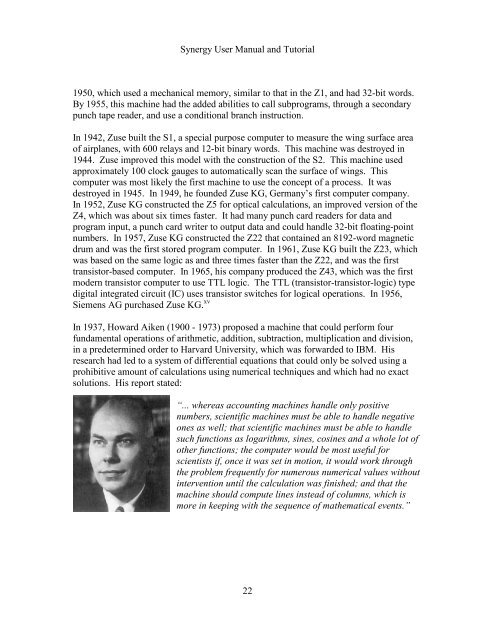Synergy User Manual and Tutorial. - THE CORE MEMORY
Synergy User Manual and Tutorial. - THE CORE MEMORY
Synergy User Manual and Tutorial. - THE CORE MEMORY
Create successful ePaper yourself
Turn your PDF publications into a flip-book with our unique Google optimized e-Paper software.
<strong>Synergy</strong> <strong>User</strong> <strong>Manual</strong> <strong>and</strong> <strong>Tutorial</strong><br />
1950, which used a mechanical memory, similar to that in the Z1, <strong>and</strong> had 32-bit words.<br />
By 1955, this machine had the added abilities to call subprograms, through a secondary<br />
punch tape reader, <strong>and</strong> use a conditional branch instruction.<br />
In 1942, Zuse built the S1, a special purpose computer to measure the wing surface area<br />
of airplanes, with 600 relays <strong>and</strong> 12-bit binary words. This machine was destroyed in<br />
1944. Zuse improved this model with the construction of the S2. This machine used<br />
approximately 100 clock gauges to automatically scan the surface of wings. This<br />
computer was most likely the first machine to use the concept of a process. It was<br />
destroyed in 1945. In 1949, he founded Zuse KG, Germany’s first computer company.<br />
In 1952, Zuse KG constructed the Z5 for optical calculations, an improved version of the<br />
Z4, which was about six times faster. It had many punch card readers for data <strong>and</strong><br />
program input, a punch card writer to output data <strong>and</strong> could h<strong>and</strong>le 32-bit floating-point<br />
numbers. In 1957, Zuse KG constructed the Z22 that contained an 8192-word magnetic<br />
drum <strong>and</strong> was the first stored program computer. In 1961, Zuse KG built the Z23, which<br />
was based on the same logic as <strong>and</strong> three times faster than the Z22, <strong>and</strong> was the first<br />
transistor-based computer. In 1965, his company produced the Z43, which was the first<br />
modern transistor computer to use TTL logic. The TTL (transistor-transistor-logic) type<br />
digital integrated circuit (IC) uses transistor switches for logical operations. In 1956,<br />
Siemens AG purchased Zuse KG. xv<br />
In 1937, Howard Aiken (1900 - 1973) proposed a machine that could perform four<br />
fundamental operations of arithmetic, addition, subtraction, multiplication <strong>and</strong> division,<br />
in a predetermined order to Harvard University, which was forwarded to IBM. His<br />
research had led to a system of differential equations that could only be solved using a<br />
prohibitive amount of calculations using numerical techniques <strong>and</strong> which had no exact<br />
solutions. His report stated:<br />
“... whereas accounting machines h<strong>and</strong>le only positive<br />
numbers, scientific machines must be able to h<strong>and</strong>le negative<br />
ones as well; that scientific machines must be able to h<strong>and</strong>le<br />
such functions as logarithms, sines, cosines <strong>and</strong> a whole lot of<br />
other functions; the computer would be most useful for<br />
scientists if, once it was set in motion, it would work through<br />
the problem frequently for numerous numerical values without<br />
intervention until the calculation was finished; <strong>and</strong> that the<br />
machine should compute lines instead of columns, which is<br />
more in keeping with the sequence of mathematical events.”<br />
22

















